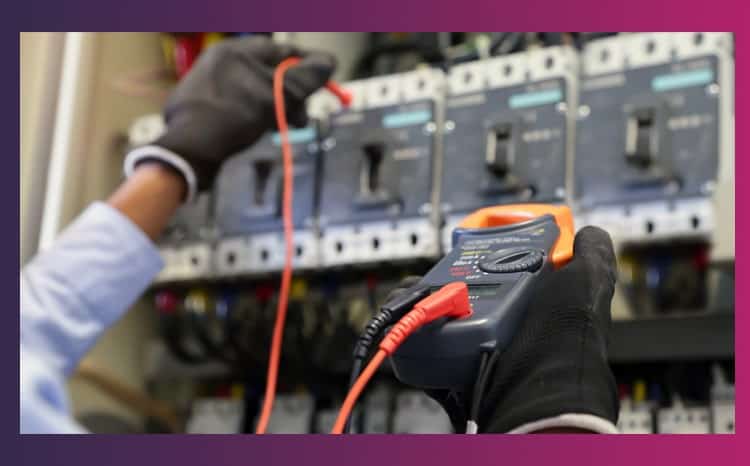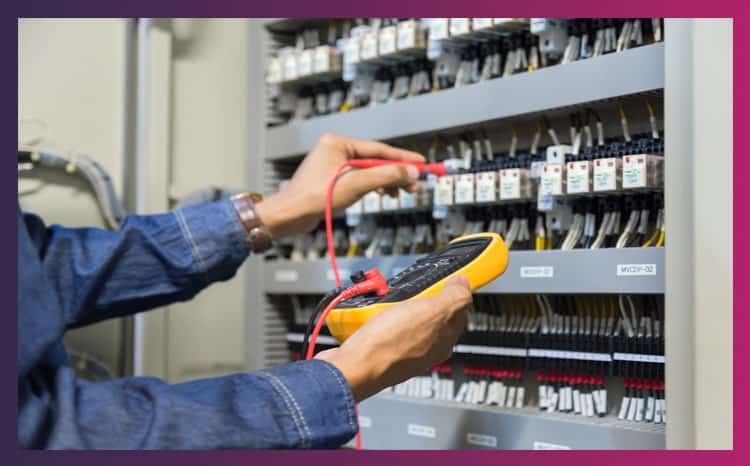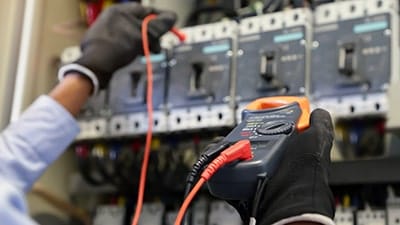
Last summer, when I was trying to fix a loose wire of the plug at home, I used a non-contact voltage tester, but it gave me a false-positive.
I will explain how I know this in this coming section.
Using a non-contact voltage tester giving false-positive may prove to be risky, and that is why I decided to write an article on how to prevent non-contact voltage tester giving false-positive results.
Best Way to Prevent Non-Contact Voltage Tester Giving False-Positive
The best way to prevent non-contact voltage tester false-positive is by checking for the causes that lead to false-positive before using the tester.
Various factors like ghost voltages, static voltages, stray voltages, and feedback give out false-positives.
Noticing these conditions prior to checking would help you take measures to prevent false-positives.
There are many devices available in the marketplace that you could use to confirm the presence of AC current in the object.
The most common of them is the non-contact voltage tester.
I recommend using this as it is very handy and portable.
However, there would be times when your voltage tester gives a false-positive result.
Getting a false-positive does not mean that your tester is faulty.
The non-contact voltage tester does its job by informing you about the presence of voltage.
It is always a good practice to cross-check with other advanced equipment.
I have a strict rule to use alternative devices to cross-verify while using non-contact voltage tester because I know they sometimes give out false-positives.
You must understand how these non-contact voltage detector testers work to understand the concept of false-positive.
In the coming sections, I will explain the functioning of a non-contact voltage tester, various factors that lead to non-contact voltage tester false-positives, and how to properly use a non-contact voltage tester.
Read ahead to find everything in detail.
How Is The Functioning Linked To Non-Contact Voltage Tester False-Positive

As I told you before that you need to carefully understand the mechanism of the non-contact voltage tester in order to digest the concept of false-positive.
Here is how a non-contact voltage tester works.
A non-contact voltage tester works by a process called capacitive coupling.
It detects the changing electric field around the AC current objects.
These non-contact voltage testers don’t have to get in direct contact with the article for testing the nearness of current.
The capacitor comprises two conveyors that are essentially kept isolated with the assistance of a non-conduit, otherwise called a dielectric.
At the point when you associate an AC voltage to a capacitor, the current would stream over the dielectric or non-conduit.
That’s how the circuit is completed even without wire.
As you have understood above that the non-contact voltage tester can be used without even touching the object, you can confer that there are chances of a lot of interference.
Ghost voltages, static voltages, stray voltages, and feedback give out non-contact voltage tester false-positives.
Let us try to understand each of these in detail.
Ghost Voltage
Ghost voltage is a term that you will hear a lot in technical industries and is the name of a quite certain marvel.
I have seen it utilized differently to allude failing under load or high resistance connections and sometimes even basic open circuits.
So what does it actually mean?
A ghost voltage is transient, apparently, source less voltage.
It does have a source. You know how, when the current moves through a conductor, it delivers an attractive field?
Well, that attractive field can, thus produce a voltage in another conductor.
That delivered voltage will then simply hang out in that conductor, much the same as the charge does in a battery or a capacitor until it is given away to neutral.
Does this imply ghost voltage can power the load?
Not under any condition – the second there’s a way to neutral, the ghost voltage seeps off immediately.
So how can it be that your non-contact voltage tester still recognizes it?
That is on the grounds that a standard non-contact voltage tester is intended to give however much impedance to current flow as could be expected.
The purpose is that you can get an estimation while influencing the circuit.
It means that your tester won’t seep off the ghost voltage and your non-contact voltage tester false-positive.
There’s a simple method to abstain from being befuddled by ghost voltage, and that is to utilize a loading meter.
As its name proposes, a loading meter is intended to go about as a heap in the circuit it’s estimating, with generally low impedance – sufficiently low to promptly seep off ghost voltage and keep you from being faked out.
In case you’re estimating a 120 VAC circuit and you read 120 volts on your loading meter, at that point you know beyond all doubt that one of your leads is on a substantial line and the other on a legitimate impartial. No mystery required.
Most importantly, while doing AC voltage estimations, you ought to consistently utilize a loading meter.
There’s just no explanation not to. It will give you more exact readings, it will affirm whether a force gracefully is really prepared to do passing current, and it will shield you from getting deceived by any creepy ghost voltage.
Static Voltage
Static voltage can be an aggravation or even a peril. The energy that causes your hair to stand can likewise harm gadgets and cause blasts.
Almost all electric charge known to mankind is conveyed by protons and electrons.
Protons are said to have a charge of +1 electron unit, while electrons have a charge of −1, although these signs are totally self-assertive.
Since protons are commonly restricted to nuclear cores, which are thusly embedded inside iotas, they are not close to as allowed to move as are electrons.
Consequently, when we talk about electric flow, we mean the progression of electrons, and when we talk about static electricity, we mean an imbalance among negative and positive charges in objects.
This is one of the biggest reasons for non-contact voltage tester giving false-positive results.
Reasons for Static Charge Development
One normal reason for static charge development is contact between strong materials.
When two articles are scoured together to make static electricity, one item surrenders electrons and turns out to be all the more emphatically charged while the other material gathers electrons and turns out to be all the more contrarily charged.
This is on the grounds that one material has feebly bound electrons, and different has numerous opening in its external electron shells, so electrons can move from the previous to the last making a charge awkwardness after the materials are isolated.
Materials that can lose or pick up electrons along these lines are called triboelectric.
One normal case of this would be to rearrange your feet across the carpet, especially in low humidity which makes the air less conductive and expands the impact.
Since like charges repulse one another, they will, in general, relocate to the furthest points of the charged item to escape from one another.
This is the thing that makes your hair remain on end when your body takes on a static charge.
At the point when you at that point contact a grounded bit of metal, for example, a screw-on a light switch plate, this gives a way to ground to the charge that has developed in your body.
This abrupt discharge makes an obvious and perceptible flash through the air between your finger and the screw.
This is because of the high likely distinction between your body and the ground which can be as much as 25,000 volts.
Static stun can harm fragile gadgets. Another source of static charge is the movement of liquids through a funnel or hose.
In the event that that liquid is combustible, the sparkle from an unexpected discharge could bring about a fire or blast.
Individuals who handle fluid energizes should take incredible consideration to maintain a strategic distance from charge development and unexpected discharge.
Stray Voltages
Stray voltage is the presence of an electrical potential between two objects that are not supposed to have any voltage difference between them.
There is always some voltage that would exist between two grounded objects because of its power system.
However, you can observe large voltages on the electrical equipment if there is any fault in the power system, especially insulation failure. This another reason behind non-contact voltage tester giving false-positive.
It is important to note that these stray voltages are not intentional but are very common.
Your non-contact voltage tester giving false-positive whenever it encounters a stray voltage.
You would be astonished to know that almost any location could have a stray voltage and it is rare not to find one in offices or homes.
One of the basic reasons behind this is the standard wiring which has only one hot wire, one neutral wire, and a ground wire.
When such stray voltage exists, they try to find a way to go through any conductor.
This might happen if you have a weak or failed connection on account of the flow of electrons via earth, metal building, fences, etc.
Let me briefly cover the reasons behind stray voltages that result in non-contact voltage tester giving false-positive results.
Coupled Voltages
Some ungrounded metal objects that remain close to the electric field carrying alternating current can contain voltage levels by capacitive coupling.
These coupled voltages might trick your non-contact voltage tester in false-positive results.
Leakage Through Insulation
An alternating current or AC can easily flow through the physical barrier on the account.
If the insulation around the wires is not done properly, then this current can pass through any conductor.
This sometimes tricks the non-contact voltage tester giving false-positive results. It also one of the major reasons for stray voltage.
Induced Voltage
This happens when a long conductor forms an open-grounded-loop under or parallel to distribution lines.
As it involves a real flow of current, it can be very dangerous. You can experience stray voltage due to this.
Degraded Insulation
Stray voltages are also caused due to insulation is gone bad over a period of time.
As explained earlier, AC current can easily escape through any conductor material in close contact.
Because of degraded insulation, a voltage can easily stray through.
Such a voltage is also known as a stray voltage through degraded insulation.
Leakage From Single-Wire Earth Return
Stray voltage can also occur if there is leakage from single wire earth return electricity distribution that is usually done in rural areas.
Neutral Returns Current From Ground
When the load is unequal in the three-phased system, some current is left in the neutral conductor.
Since both the essential and optional of the transformer are grounded, and the essential ground is grounded at more than one point, the earth frames an equal return way for the neutral current, permitting some portion of the impartial current to constantly course through the earth.
This causes a stray voltage.
Electrolysis or Corrosion
Sometimes due to electrolysis or corrosion, you may experience stray voltage.
Disparate covered metals can work as the posts of a galvanic cell, utilizing soggy soil as the electrolyte.
The stray direct currents in the soil might counteract the anti-corrosion effect of a cathodic protection system.
Feedback
When there is an open impartial on the utility and the framework isn’t fortified.
Voltage can show up in the home in any event, when the fundamental breakers are off.
This also one of the reasons, why non-contact voltage tester giving false-positive results.
Proper Steps to use Tester to Avoid Non-Contact Voltage Tester Giving False-Positive Results

I know, it seems kind of childlike to list all the things point-wise, but it is also easier to understand that way.
Below, I have mentioned a few pointers that would guide you on how to properly use the non-contact voltage tester.
- Pick the one that best non-contact voltage tester that meets your requirements.
- Check if the batteries work fine.
- Check the tester on a realized voltage source before utilizing it on the presume regions.
- Wear defensive attire fitting to the assignment. They are protecting gloves, shoes, etc.
- I suggest that you always start with the main service disconnect. First, check if the outer cover is live and then remove it. Check for any rust or damage on the front body, and if all is good, then you can remove it.
- After removing it, check if the system is grounded and bonded correctly or not. You must check for any overheating or corrosion and also check if the installation is done professionally or not.
- Check for any moisture as water would increase the risk of electrocution. If you find any moisture content, then it is best to avoid working around it as it is highly risky.
- If you are checking any component that you suspect of having live power, then first you need to clear all projecting parts that might be energized.
- Check if the object is shielded as panel covers or wet insulation might dampen the electric field and trick to result in a non-contact voltage detector false-positive.
- Make sure that there is no ghost voltage present caused by capacitance coupling as this would cause non-contact voltage tester giving false-positive results.
- Always cross verify the presence of voltage with the help of advanced equipment like a multimeter. Just because the non-contact voltage tester shows an absence of power, it does not mean that there cannot be any live current in it.
- Never touch the system unless you are very sure that it is not energized.
Final Thoughts

Working with live systems loaded with the current is a risky affair.
You need to be very careful when using your non-contact voltage tester to check the presence of AC current in any object.
As mentioned before there are times when your non-contact voltage tester would give false-positive.
Whether you are an expert electrician or a novice DIYer, working around electricity should always be taken seriously and proper safety measures must always be practiced.
The above write-up also focused on various aspects of non-contact voltage tester usage that would enable you to understand the reasons for false-positive.
The main aim of this write-up was to explain to you how to prevent non-contact voltage tester false-positive.
Moreover, the tips and tricks section about using a non-contact voltage tester would help you avoid most of the false-positive situations.
I hope this article helped you gain valuable insight into the topic and helps you take proper precautions while you work around electricity.
I hope you enjoyed reading this article!




